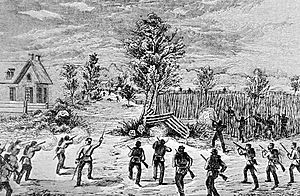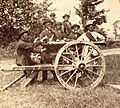Battle of Eccles Hill facts for kids
Quick facts for kids Battle of Eccles Hill |
|||||||
|---|---|---|---|---|---|---|---|
| Part of the Fenian Raids | |||||||
 The Battle of Eccles Hill. Contemporary illustration. |
|||||||
|
|||||||
| Belligerents | |||||||
| Commanders and leaders | |||||||
| John O'Neill | William Osborne Smith | ||||||
| Strength | |||||||
| 680 militia 1 cannon |
600 militia | ||||||
| Casualties and losses | |||||||
| 2 dead 18 wounded 1 cannon captured |
None |
||||||
| Official name: Battle of Eccles Hill National Historic Site of Canada | |||||||
| Designated: | 1923 | ||||||
The Battle of Eccles Hill was a fight that happened on May 25, 1870. It was part of a series of attacks called the Fenian Raids. These raids were led by John O'Neill and the Fenian Brotherhood. The Fenian Brotherhood was a group of Irish-Americans. They wanted to make Great Britain give Ireland its independence.
In 1870, the Fenians crossed into Canada near Eccles Hill. There, they met Canadian home guards and volunteers. The Canadians, including regular people with weapons, fought back. The Fenians were defeated and had to retreat. They had expected a big win, but it didn't happen.
Contents
Who Were the Fenians and John O'Neill?
The Fenian Brotherhood was a group of Irish people living in the United States. They wanted Ireland to be free from British rule. They believed that if they attacked Canada, which was part of the British Empire, it would force Britain to let Ireland become independent.
John O'Neill was a leader of the Fenian Brotherhood. He planned for the Fenians to attack deep into Canada. He wanted them to reach places like St. Jean and Richmond in Quebec. These towns were important because they were near waterways and the Canadian Railroad. O'Neill hoped to have many attacks happening at the same time.
On May 25, 1870, O'Neill had over 200 fighters. He traveled to Franklin, Vermont, and then towards Eccles Hill in Canada. Before crossing the border, a U.S. Marshal named George Foster warned O'Neill's men. He told them about new laws that stopped people from attacking other countries from U.S. soil. The Fenians ignored the warning and kept going. The marshal also knew that Canadian soldiers were waiting for them at Eccles Hill. British and Canadian officials had spies who told them about the Fenians' plans.
The Battle Begins at Eccles Hill
On the morning of May 25, 1870, the Fenian fighters, who called themselves the Irish Republic Army, were marching towards Eccles Hill. They had gathered in Vermont to start their attack on the Montreal area. A similar Fenian attack had happened in 1866.
General O'Neill gave the order to charge. About 400 Fenian men charged into Canada. Meanwhile, the Canadians had secretly secured the border in Ontario and Quebec. They did this without letting the Fenians know they were there.
At the top of Eccles Hill, Canadian militia and armed citizens were waiting. When the Fenians charged, a man named James Pell from Dunham crawled to the top of the hill. He aimed his musket at the first person wearing green. The Fenians wore green jackets, often leftover from Union army uniforms. James fired his shot, hitting a Fenian named John Rowe in the neck.
After Pell's first shot, a storm of bullets came from the Canadian side. The Canadians were hidden behind the hill. The shooting quickly became a steady fight. Many young Fenian soldiers panicked when they saw their friend fall and experienced combat for the first time. This stopped the Fenian advance. They took cover and fired back.
Canadian Reinforcements and Victory
Lieutenant-Colonel William Osborne Smith quickly arrived with more Canadian militia volunteers. Together with the armed citizens, the Canadian militia charged the Fenians. The Fenians were forced to fight defensively. Many Fenian soldiers ran away and hid behind walls, or jumped into the water. During this fighting, a Fenian named William O'Brien was shot and killed.
The Canadians pushed the Fenians back, forcing them to retreat. The Fenians left behind their cannon and two dead soldiers. This was a big victory for the Canadian battalion and volunteers. The Canadians were outnumbered by the Fenians almost six to one. Even so, the Canadians had no one killed during the battle.
What Happened After the Battle?
After the battle, as O'Neill and his men were leaving, they stopped to help an injured Fenian soldier. At that moment, U.S. Marshal George P. Foster rode up. He arrested O'Neill for breaking neutrality laws, which meant he had used U.S. land to attack another country.
With their leader arrested, many Fenian soldiers started to leave their groups. Fenian officers had no choice but to abandon their positions. They tried to find safe places until they could escape under the cover of night. When the Canadian counter-attack happened, the Fenian soldiers were already losing hope. They ran away instead of fighting. They threw away their ammunition, food, and water to make it easier to escape.
The Fenians had believed this would be a great victory for them. But they were wrong. Two days later, some Fenians crossed the border into Quebec again, this time near Trout River. However, the 50th Canadian Battalion, the Montreal Volunteer Artillery, and the British 69th Regiment quickly dealt with this new attack. The Fenians fled back across the border once more. Again, no Canadians were killed.
Remembering the Battle
Today, there is a monument on Eccles Hill Road in Frelighsburg, Quebec. It marks where Canadian volunteers and home guards fought off the Fenian raiders on May 25, 1870. The monument is made of granite. It was placed on Canadian soil to give a sense of national pride, even though the actual fighting happened just south of the Canada–United States border.
On July 1, 1902, more than 30 years after the battle, the monument was put in place. This was done by the Canadian government, led by Wilfrid Laurier, working with the Missisquoi Historical Society. Many people came to the opening ceremony. They wore red scarves to honor the veterans who were there. During the battle, many Canadians didn't have uniforms, so they wore bright red scarves over their shoulders. Red streamers were also placed in the bushes along the road to guide the many guests to Eccles Hill.
Veteran soldiers from the Missisquoi 60th battalion proudly wore new military medals. These medals were engraved with "Fenian Raids of 1866–1870." After 30 years, the Canadian government decided to honor all the veterans who helped push back the Fenian invasion. Thanks to records kept in 1866 and 1870, we still know today who was part of the volunteer Canadian militia.
Images for kids





